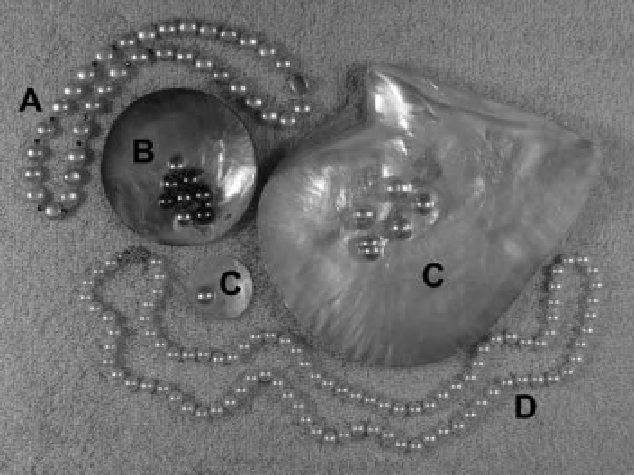Geoscience Reference
In-Depth Information
Figure 11-11.
Selection of fresh- and salt-water pearls and mother-of-pearl shells (see Color Plate 11-11). A.
Chinese, multi-colored fresh-water, probably
Hyriopsis cumingi
. B. Black-lipped pearl oyster,
Pinctada
margaritifera
. Diameter of shell
=
85 mm. C. Golden-lipped pearl oyster,
Pinctada maxima
. D. Japanese akoya
pearls,
Pinctada fucata
. White with rose overtone. Photo by S.W. Aber and J.S. Aber.
implant in the host. The bead is mother-of-pearl,
usually from a fresh-water mollusk, such as
the Mississippi River pigtoe clam (
Pleurobema
beadleianum)
, which is commonly cultured on
North American pearl farms (Wise 2006).
The mantle tissue and bead stimulate the host
oyster to secrete layers of nacre around the
implanted irritant; the i nal thickness is deter-
mined by length of time in the water before
harvest. Culturing may also be accomplished
without a bead, using a tissue implant only; the
tissue alone creates the
activation
, not a nuclea-
tion process, to stimulate the host oyster to
secrete nacre, and the resulting pearl is all nacre
(E. Strake, pers. com. 2011). For salt-water pearls,
only one nucleus is implanted; however, cul-
tured fresh-water pearls most often use implan-
tations that are nucleated with up to 50 pieces
of tissue (Wise 2006). The size of implant bead
in pearl oysters depends on the size of mollusk;
South Sea pearls are among the largest in size
as compared to akoya and fresh-water pearls.
Pearl farming also takes place in fresh-water
environments such as ponds, lakes, and rivers.
China harvested fresh-water pearls in the thir-
teenth century and today is a major supplier of
all sizes, shapes, qualities, and quantities of
fresh-water pearls in various natural colors
(Pearl-Guide 2011). The commercial fresh-water
cultured-pearl industry in the United States was
started by John and Chessy Latendresse, who
pioneered American pearl production in the
1950s, created the “all-American pearl,” and
made the American Pearl Company a tourist
destination in Tennessee (Burch 1995). Each
pearl takes some 3-5 years to grow; in contrast,
many Asian fresh-water pearls are completed in
only one year. The Latendresses showed that the
Japanese akoya would accept North American
mussel shell nuclei, and exporting farm-grown
mussel shells overseas lessened the pressure on
natural mussel populations.
Cultured-pearl farming is a business that may
be in balance with wetland ecosystems. It is an
operation that neither pollutes nor drains wet-
lands because the essence of pearl farming is in
generating and sustaining life. Although wild
mollusks are captured, bred, and grown in cap-
tivity, they are not used as a food source, but
rather as pearl hosts and donors. Cultured-pearl
farming provides a sustainable alternative to
overharvesting wild mollusks for natural pearls
or shells. Each year more mollusks are released
back into the ocean by pearl farmers than were





